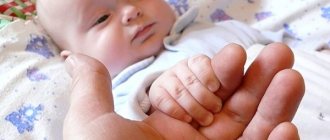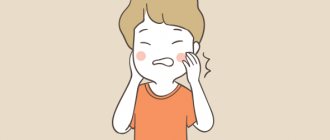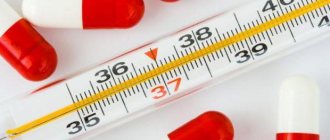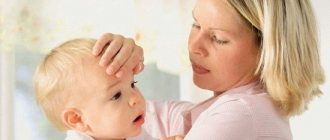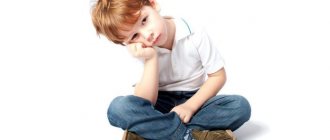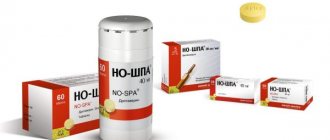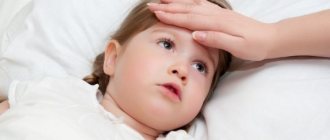Temperature norm and downward deviations
Lower thermometer readings in newborns and infants may indicate different levels of danger.
- 32-27℃ and less – severe hypothermia. Leads to deep coma. Urgent resuscitation measures are needed to recover from this critical condition.
- 33-32℃ – average. Fainting or the child is very lethargic. An ambulance is needed. The cause may be severe hypothermia or serious functional impairment. At 32℃, the ability to independently maintain the body’s thermal balance is exhausted. After crossing this border, only gentle, careful external warming can help to return to normal.
- 33-34.9℃ - mild hypothermia, if for a short time, then most often due to ordinary hypothermia, which is easily eliminated by careful and gradual warming with mother’s hugs, suckling at the breast or warm drink, putting on more clothes. Or an indicator of some kind of pathology. Then, after performing the above actions, the temperature will still remain low.
- -36.5℃ is simply a low temperature, if short-term, it is explained by thermoregulatory processes within normal limits.
If the baby's temperature is 35℃
At 35℃ you need to look at the child’s condition. Frightening symptoms:
- weakness - no strength even to cry,
- excessive sleepiness or moodiness,
- loss of appetite,
- dyspnea,
- pale skin,
- frequent regurgitation.
If these additional signs are not present, the conditions in the room are comfortable and the baby is dressed in accordance with them, then perhaps the temperature of 35 at the moment is a variant of the norm.
A healthy baby, who was born full-term and eats well, has a powerful “thermal reactor” inside. A baby produces several times more energy per kilogram of weight than mom or dad. But not always. When a baby sleeps, its heat production drops significantly, and the thermometer can show 36 or even 35℃. This can cause panic for parents. But if the temperature rises by half a degree or more after the baby woke up and ate, then there is no reason to worry.
The baby’s body does not yet know how to save heat. Therefore, it easily releases it through the skin and when breathing cool air. A baby can easily overheat due to excess clothing, being in a warm room or on a hot street. But it can also quickly become hypothermic if left without clothes. In practice, parental care is ten times more likely to lead to overheating than to hypothermia.
Another important point is how, where and with what thermometer you measure. We write the values for the mercury thermometer, dry axilla and 5 minutes of measurement. Electronic and infrared devices are not always properly tested and may give inadequate readings. The standards for measurements in the mouth, ear and rectum are different. And these methods are inconvenient when applied to infants. A mercury thermometer has one drawback - its poisonous contents. It must be handled very carefully.
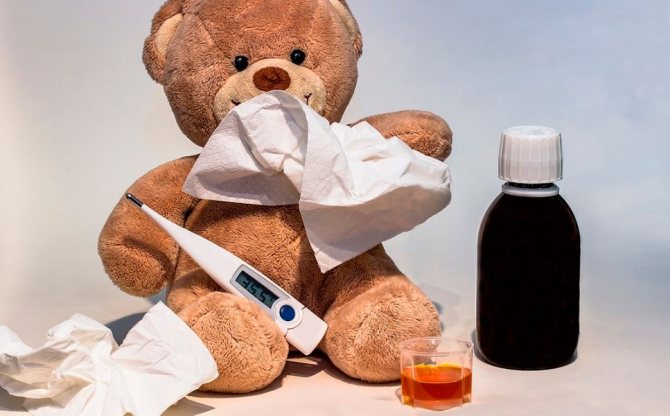
If you measure a low temperature in a child under one year old, do not rush to panic. Repeat the measurement with a more reliable thermometer, make sure its readings are correct. Of course, if you see that the baby is in good condition and in a good mood. If anything is concerning, call a doctor. If you have strong concerns, go to the ambulance.
How to help at home
When the child has a fever, he needs rest and plenty of fluids. You can’t dress him warmly, but you also need to make sure that your hands and feet don’t freeze. Along with an antipyretic, it is not prohibited to wipe the baby with a damp towel. The water should be warm, a little cooler than the baby’s body temperature, about one degree. Do not use solutions containing alcohol for wiping.
The baby should be in a ventilated room; dry air will only harm his well-being.
Hypothermia in the first year of life: external causes
Why does a baby have a low body temperature immediately after birth?
- All newborns experience hypothermia below 36℃ on the first day. It is called transient and is associated with adaptation during the transition to another environment. From water to ground-air. From 37℃ inside the womb to 20℃ in the delivery room. After 12 hours, maximum 24 hours, the baby’s body adapts, and the temperature rises to 36.1-37℃.
- Premature and low birth weight babies do not yet have the ability for normal thermoregulation. Therefore, they are placed in incubators with strictly controlled conditions.
A child’s temperature in the first three months of life fluctuates greatly, up to 0.6℃, under the influence of external conditions, depending on the humidity and heat in the room, clothing, and activity. During sleep it decreases noticeably.
The cause of hypothermia in a baby 1-12 months old can be:
- malnutrition or incorrectly composed diet and diet;
- tight swaddling - it needs to be changed to loose or wear sliders;
- wet diapers or a diaper that has not been changed for a very long time;
- prolonged air baths - they need to be done systematically and gradually, gradually increasing the time and lowering the temperature.
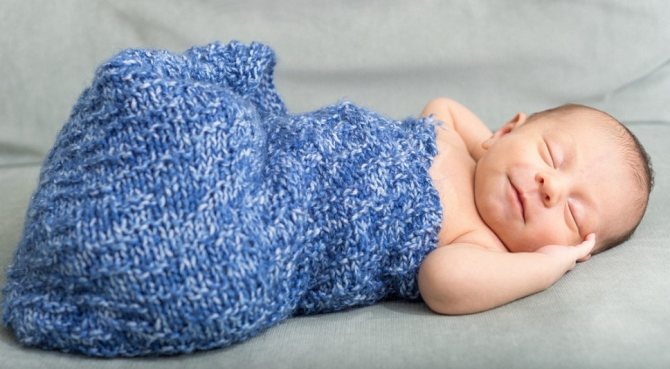
How does a baby's temperature manifest?
Until approximately one year of age, the average body temperature of a baby remains within the range of 36.6-37.4 degrees, while there is no harm to its health. Later, the thermoregulation function improves and the thermometer readings become more stable. If the temperature rises after eating, strong screaming, active movements or crying, this is considered normal. Signs by which an increase in temperature can be determined:
- rare urination;
- sweating of the body and head;
- hot, reddened forehead skin;
- hot extremities (the child did not eat or cry);
- baby anxiety.
What to do to prevent your child from getting hypothermic?
Every adult knows what to do to avoid freezing. The same rules apply to infants, but their immature thermoregulation must be taken into account.
When going for a walk, wear one more layer of clothing for your child than for yourself. That is, if you are wearing a T-shirt, a sweater and a warm jacket - 3 layers, then the baby should have 4 of them:
- cotton vest and rompers,
- knitted suit,
- sheepskin jumpsuit
- a warm blanket.
And a diaper to go with it all is a must. It is strictly forbidden to be outside in wet clothes. Of course - thick socks, a cap and a winter hat, a scarf in the case of a loose collar on the overalls.
It is necessary to take into account the air temperature outside. Dr. Komarovsky believes that the first walks may well be on the balcony from the 10th day of life.
You can start walking in spring, autumn and summer at any temperature outside; in winter – no lower than -10℃. If it's colder outside, wait. Ideal - during a thaw from 0℃. Walking time should be increased gradually. If it’s 0℃, you can start with 10 minutes; at -10, the first walk is 2 times shorter. And then every day:
- 5 minutes more if the outside temperature is from -5 to -10℃;
- 10 minutes more if from 0 to -5℃.
You should not walk with your baby at temperatures below -15℃. The danger of hypothermia and frostbite is too great.
The first balcony trip at temperatures above 0℃ can take up to 20 minutes. On the second day you can already do it 2 times for half an hour. Every day, increasing the time by another 30 minutes, by the end of the month you can already be on the balcony almost all day while sleeping, and a baby at this age sleeps 18-20 hours a day. The only pity is that often the main part of wakefulness occurs at night, when the mother really wants to fall asleep herself.
The first contact with the cold outside is stressful for the baby. Therefore, it is better if the starting walk is in dad or mom’s arms, and not in a stroller.
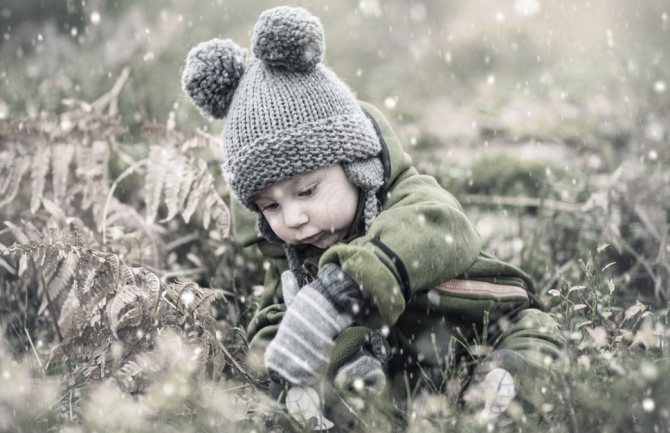
Medication methods for reducing fever in a newborn baby
The safest medications for newborns are those made on the basis of paracetamol - Panadol, Efferalgan, Tylenol, etc.
It is strictly forbidden to mix drugs into infant formula. And the main thing that parents should remember, especially when it comes to a newborn child under 3 months of age, is that the name of the drug, as well as the norms of use, should be prescribed only by a doctor after examining the baby.
Causes of low temperature
External factors leading to hypothermia can be eliminated quite easily. But as for various pathologies that are manifested by low temperatures, they can be difficult to identify. You need to measure your temperature regularly, and not only after sleep, when it should be slightly lower.
If the temperature remains low even in the evening, after physical activity, crying or screaming, or eating, then you should consult a pediatrician.
And carefully monitor the child to see if any unusual or alarming signals appear. Possible reasons for a constant temperature of 35-36 in infants
| Causes | Other symptoms | What to do? |
| Recovery from a viral infection | Pallor, loss of strength | Vitamins, fresh air, interesting activities |
| Anemia | Dry skin, poor appetite, poor weight gain | Donate blood for hemoglobin - up to six months it should be 100 g/l, at 6-12 months 140 g/l. Contact a pediatric hemologist. |
| Worms | Abnormal bowel movements, dark circles under the eyes | Get a stool test and get treatment |
| Intestinal infection | Vomiting, diarrhea, dry skin, crying without tears | Desolder to reduce dehydration, call an ambulance |
| Congenital hypothyroidism | Low activity, slow development, frequent colds | Tests for thyroid hormones. Observation by a pediatric endocrinologist. |
| Hypoglycemia | Apathy, baby sucks weakly, sudden cries | Blood sugar test. Frequent feeding with special mixtures. In severe cases, glucose is administered intravenously. |
If it decreases after a high
It often happens that a baby has a low temperature after a high one. This can be explained by the following reasons:
- weakening of the body after acute respiratory viral infection or bacterial infection;
- residual effect of antipyretic drugs;
- a side effect of vasoconstrictor nasal drops is especially dangerous, as it can lead to critical disturbances in blood circulation.
If the baby’s temperature remains constantly at 35 after a high temperature, he is very sleepy and weak, then perhaps this is a side effect of the medications. Then you need to call an ambulance and go to the hospital for urgent detoxification.
When the temperature does not fall below 35℃ and does not remain at this level around the clock, then most likely this is a normal period of recuperation after illness. Hypothermia at this time occurs in the mornings, and by the evening the baby’s temperature rises to normal or subfebrile 37-37.5℃.
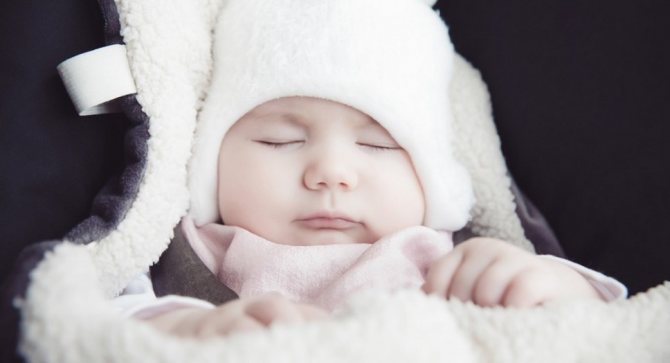
How to help your baby finally recover? If the time has already come for complementary feeding, you need a varied diet so that there are enough vitamins, especially C, to improve the immune system. Interesting and varied activities, fresh air, drink more fluids to remove accumulated microbial and medicinal toxins.
What temperature should a child have?
The norm depends on the age of the child. For a one-year-old baby, thermometer readings from 36 to 37.4 degrees are considered normal. By the end of the first year of life, they are established in the range from 36 to 37 degrees.
When there are no other symptoms of the disease, you should try to create comfortable conditions for the baby, and everything will return to normal. If the thermometer shows 38 degrees, you need to call a pediatrician at home. When the body temperature is above 39 degrees, it’s time to call an ambulance. The arriving emergency doctor will make a primary diagnosis and send a call to the district pediatrician the next day.
